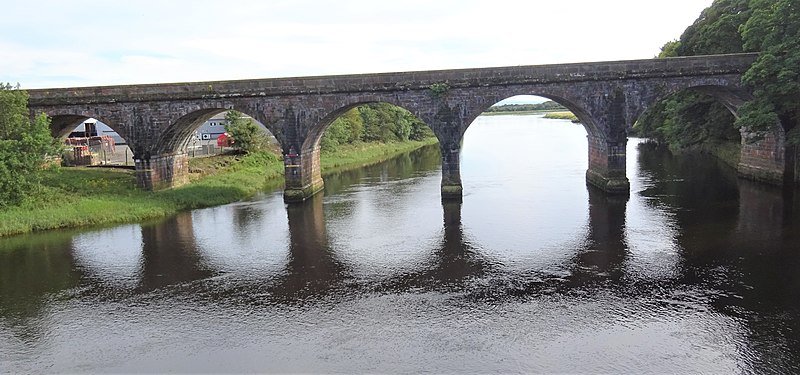A PDF version is available here.
It has been a busy (by my modern standards) month. A talk to the IStructE History Group about how badly we are caring for these bridges. That should be available here. I also did a repeat of my talk on being wrong.
Meanwhile, since I am still doing no travelling, I was running out of ideas till I considered comparing the 135 BoMs with my photo archive. I think there are several on the Glasgow and south west from the early 2000s that are worth a look.
Let’s start at Annan. I didn't notice at first that my photos covered two viaducts, one square and one skew. Further investigation shows these to be Annan Viaduct and Port Street Viaduct respectively. Apart from the skew, the construction is very similar.
I don’t have general views of my own but by the generosity of strangers we can show Annan Viaduct:
Wikicommons: Rosser1954, CC BY-SA 4.0 licence
And Google Streetview allows us to see Port Street Viaduct as a whole here. My copy below has been pushed in Affinity Photo to reveal details on the soffits.
There are several things to note in this image. There are four modestly skew spans of 40ft (12.2m) span and 10ft rise. I would expect that span to be on the skew (parallel to the arch edges, not "square" to the pier faces), the same centres surely having been used for both viaducts. I hadn’t thought that far when I was there 20 years ago.
What next? Look how high those drains are! We know enough about John Millar's bridges to say with some confidence there will be solid backing about halfway up the arch then internal spandrel walls (usually one under each rail) that pass right over the arch crown. Above that, the voids are capped with stone. Those stones probably correspond to the ashlar band below the nosings. There will be a sump to collect water behind the drains.
If we look up at the soffit, we see a run of water down the centre line from the crown towards the springing. So what is the drain doing? If the slab deck was built flat and the arch settled even slightly, the water would collect at mid span, not at the drain. Eventually, such water proofing as there is will break down and let that pond seep through. The upper face of the arch will not be dressed, so will be rough enough to allow water to collect above the joints and slowly seep through, de-naturing the mortar as it goes and helping with the articulation of the arch down the centre line between cracks.
Incidentally, this picture shows a square span and must be the river viaduct. Below, we return to the skew span and notice considerable damage to the spandrel wall and the edge of the arch below the drain. It is unlikely that water is penetrating from behind, at least below the top of the solid backing and the damage to the arch is restricted to the very edge, so we must assume that splash from the drain is the underlying cause. [Why not mechanical? Extends too far up to be the drain throughout surely]
The string course below the springing is also a mess. Is that water or mechanical damage? It is at least possible that the voussoir stones are harder and I have seen damage in this area in smaller square bridges, but I don’t think the cause here is the same. When you are cutting voussoirs the beds should be as close as possible to radial to the arch. In skewbacks, it is more normal to have the beds in the stone horizontal. When, as here, the skewbacks carry starter stones for the spirals, the choice is less clear cut. I suspect we are looking at radial beds sitting on a horizontal face. The front edge of the spring course is going to be particularly vulnerable at the top.
It is also worth noting that the brick edge to the arch is bonded horizontally, not on the spiral. I wonder what work that narrow strip can do. It would be interesting to see what it looks like after a further twenty years.
The behaviour on the centre line near the arch crown is interesting. Notice below that there is a vertical face of the voussoir exposed above the edge of the chamfer. The stone has rattled loose and dropped as the mortar washed out. [As these are dressed voussoirs, they are wedge shaped and can't drop far.]
In other places, the stone has cracked through. It would be good to be able to work out the immediate cause of that different behaviour (photo below).
There we have a bridge with a bit more damage to discuss. Perhaps it is worth repeating the aim of this Bridge of the Month series. It is primarily to persuade engineers to look and learn for themselves.
Till next month.







